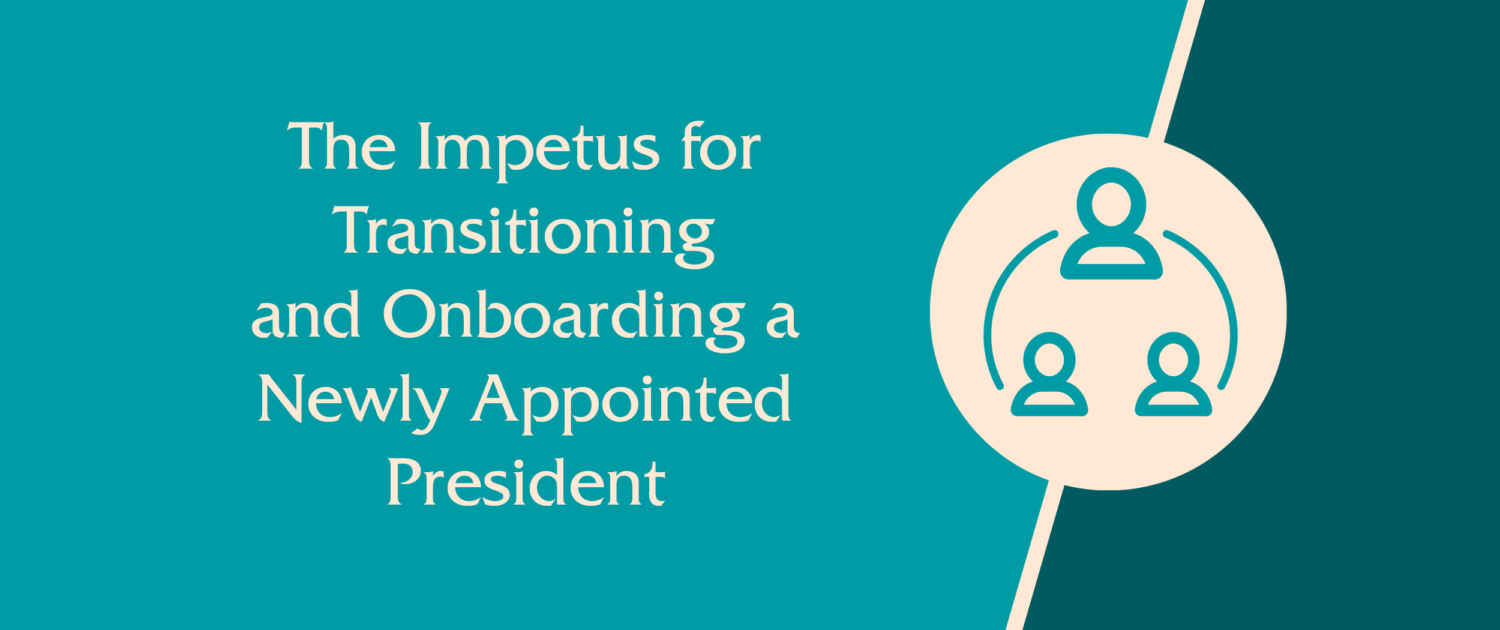
The Impetus for Transitioning and Onboarding a Newly Appointed President
By Maya Ranchod Kirkhope | November 2021
In the past decade, we have experienced shorter presidential tenures along with an increasing number of presidential derailments, many of which have been highly visible and tarnished both the president and institution’s reputations. On top of which, presidents taking office in 2021 and beyond will contend with the consequences of the 2020 pandemic that have created, and in many instances compounded, challenges, particularly around finances and enrollment.
Newly appointed presidents could continue to face faculty and staff layoffs and furloughs or increased interim placements, program and cost consolidation measures, and heightened pressure and intrusion from governing boards and system offices. Tough decisions could result in strong opposition from campus constituent groups, unions, and alumni and some have the potential to adversely affect local communities. Calls for votes of no confidence, negative press (local and national), and protest actions could become commonplace for many institutions and harsh realities for new presidents. In some situations, the fallout from the previous president’s inability to address campus conflict may also amplify an already challenging situation for a new president.
The multitude of challenges facing newly appointed presidents, particularly first-time presidents, creates an even stronger imperative to build relational capital with key members of various campus constituent groups. Forging strong relationships with influencers (including the board chair, the executive committee of the board of trustees, faculty, students, staff leadership, union leadership, alumni association leadership, members of the local community, etc.) should be part of the institution’s transition and integration strategy. More than ever, presidents will need the guidance and support of these individuals and groups as they make difficult decisions.
Although many institutions provide some form of a transition plan for their newly appointed presidents, all too often what is developed, although well intentioned, is not comprehensive, well-coordinated, nor structured. In addition, the planning is often left in the hands of one or more individuals – the board chair, the executive assistant to the president, the outgoing president, or members of the president’s cabinet – instead of a comprehensive team. Many newly appointed presidents lament the large binder of materials they must plough through and the influx of individuals all trying to garner their attention and favor during the early weeks and months upon taking office or as soon as a public announcement of the appointment is made.
In the face of these realities, the importance of a strong transition and onboarding plan is all the more fundamental. We do, however, recognize there is often confusion about the distinction between transition and onboarding and that the terms can be conflated. Although intertwined, there are distinct differences in the terminology. Transition is the process an institution undertakes to welcome and prepare a new president to usher in a fresh era in institutional life over an 8- to 12-month period. Onboarding is the process a new president undergoes to orient to the new position and institution while focusing on the unique needs and wants of the new president in preparing for the position. The amalgamation of transition and onboarding leads to integration whereby the newly appointed president is a fully functioning member of the leadership team and institutional community.
Presidential Transition
A presidential transition is the preparation and process that an institution undertakes in preparing, welcoming, and embracing a new leader. With a typical duration of eight months to a full year, it is an interconnected web or configuration of relationship-building activities that allows for various sectors, both internal and external, of the institution to weave a collaborative and systematic process of preparing for leadership change. A presidential transition is designed to set a tone and direction for the institution while allowing the new president to learn about the institution’s culture, context, and relational capital. To be optimally effective, a transition plan must be explicit, strategic, relational, and well executed and must be owned, embraced, and monitored by campus leaders and especially by the governing board. This is no small feat as there are typically a lot of moving parts that involve individuals who sometimes have differing and contradictory agendas.
In addition, at times, institutional crisis can temporarily distract and disrupt from the focus at hand. The aim is to maintain good communication through the exit of the outgoing president and the entrance of the new president, providing important opportunities for celebrating progress and keeping the campus community engaged. Although each transition is unique (undoubtedly there is no generic transition plan, presidency, or campus), staying true to the purpose and mission of a well-executed transition plan can have substantial long-term institutional benefits and ultimately lead to the successful tenure of a new president.
Presidential Onboarding
Onboarding, like transition, is not a one-off or short-term series of events but is a systematized process that could last for a full year. It is focused on the needs of the incoming president and is designed to help the president establish relationships and to build trust with both internal and external constituents. Essentially, onboarding is intended to identify areas where the president requires support to be most effective in leading the institution, i.e., ascertaining areas where the president may have limited or no experience and providing tools and guidance for the president to successfully orient and acclimate to the role, the office, and the institution. In addition, the onboarding process dissuades seasoned presidents from the assumption that what worked at their previous institutions will work at their current institutions and importantly, takes the onus off the president from asking for assistance and instead creates the conditions for support to be made available.
Academic Search’s Services
As a highly successful executive search firm that has been in operation for 40-plus years and is deeply grounded in best practices in search and leadership development, Academic Search decided very astutely to invest in supporting newly appointed presidents by offering transition and onboarding services as part of our consulting practice. Our services are comprehensive in design but also tailored to the specific needs and contexts of the presidency and the institution for each individual engagement. In the early stages of designing our services, we were intentional about focusing on the groups and individuals most directly affected by a change in the presidency and on the various factors that can lead to derailment of presidents early in their tenure. By doing so, we purposefully centered our efforts around those areas of greatest vulnerability for newly appointed presidents and concluded that there are three areas that require particular attention for successful presidential transition and onboarding: a) ensuring a structured process for introducing the president to the internal and external institutional community; b) building synergistic relationships with the president and cabinet; and c) developing a strong rapport between the president and the institution’s board of trustees.
1. Creation of a presidential transition team to assist with transition and onboarding support
Ideally established toward the tail-end of the presidential search, the presidential transition team is representative of key institutional constituent groups and is responsible for shaping the transition plan for the new president over an 8- to 12-month period, including developing a recommended list of key strategies and engagements to assist the new president.
2. Workshop/s designed to solidify relationships between the new president and the cabinet
Many presidents embark on their presidency and very quickly recognize that their expectations, wants, and needs may not conflate well with those of their cabinet members. Presidents also can assume that cabinet members will share their priorities, understand their decision-making protocols, and comprehend how they want to process information. Our workshop/s are designed to prevent those avoidable conflicts by establishing clear expectations and building synergy between the president and cabinet members early in the president’s tenure.
3. Workshop for the new president and board of trustees to clarify expectations and develop institutional priorities
The most important responsibility and decision of a board of trustees is the selection of a president. The relationship between the board and president is essentially symbiotic; one can’t be strong, effective, and successful without the other. The imperative for building synergy between the new president and board cannot be overstated and will garner substantial benefits if the time, effort, and attention is afforded to properly structuring this relationship. A workshop early in the president’s tenure will help to solidify such a rapport.
In conclusion, a strong, well-structured, and synergistic transition and onboarding plan can help to position and launch a new president toward long-term success. Thus, an institution’s investment in a presidential search should be coupled in the equally important investment of a transition and onboarding plan. Academic Search is eager to assist you with a clear transition and onboarding strategy that speaks to your particular needs and priorities.
References:
Sanaghan, Patrick H. et al. Presidential Transitions: It’s Not the Position, It’s the Transition. Rowman & Littlefield Publishers, 2009
Sanaghan, Patrick H. et al. From Presidential Transition to Integration: Strategies to Avoid Early Derailment. Academic Impressions, 2019
About the Author

Maya Ranchod Kirkhope
Vice President, Senior Consultant, and Senior Executive Coach
Maya Ranchod Kirkhope serves as Vice President, Senior Consultant, and Senior Executive Coach at Academic Search and has completed numerous searches both domestically and internationally. Ms. Kirkhope has specialized in presidential searches, created programs to strengthen the work between the president and Board of Trustees, and developed Academic Search’s signature transition and onboarding practice.







